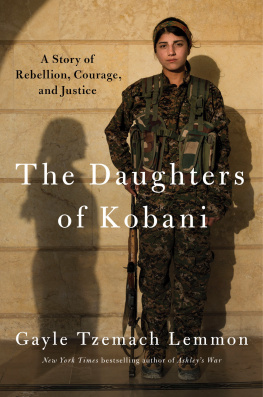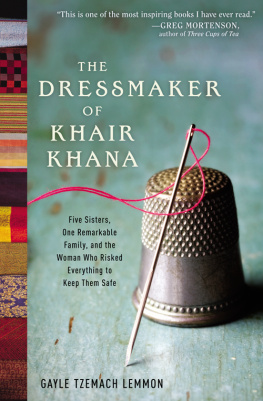Sign up for our newsletter to discover more ebooks worth reading.
EARLY BIRD BOOKS
FRESH EBOOK DEALS, DELIVERED DAILY
LOVE TO READ ?
LOVE GREAT SALES ?
GET FANTASTIC DEALS ON BESTSELLING EBOOKS DELIVERED TO YOUR INBOX EVERY DAY!
Summary and Analysis of
The Dressmaker of Khair Khana
Five Sisters, One Remarkable Family, and the Woman Who Risked Everything to Keep Them Safe
Based on the Book by Gayle Tzemach Lemmon
The summary and analysis in this ebook are meant to complement your reading experience and bring you closer to a great work of nonfiction. This ebook is not intended as a substitute for the work that it summarizes and analyzes, and it is not authorized, approved, licensed, or endorsed by the works author or publisher. Worth Books makes no representations or warranties with respect to the accuracy or completeness of the contents of this ebook.
Contents
Context
Afghanistans recent history has been one of constant conflict. War has been the only environment in which so many of todays Afghans have grown up. The turmoil generated has resulted in destruction at every level, from basic infrastructure and public services to life itself.
It is within this context that Kamila Sidiqis remarkable story takes place. Having just earned her teaching certificate in 1996, 19-year-old Kamilas dreams of becoming a teacher were shattered when the Taliban seized control of Afghanistan. Not only banned from teaching, but banned from exercising virtually all freedoms she previously knew, Kamila and every other woman in Kabul were forced to stay in their homes and renounce their careers.
Although the Taliban were technically defeated by US forces in late 2001, they have not disappeared. Moreover, their version of Islam is not unique; countless peopleespecially womenin various parts of Central and Southeast Asia, as well as the Middle East, face oppression on a daily basis. Now a major political figure and entrepreneur in Afghanistan, Kamila Sidiqi has dedicated herself to improving the lives of her fellow citizens.
Overview
One of eleven children, Kamila Sidiqi grew up in a world that had not known peace for decades. Afghanistan had been ravaged by civil war and the Soviet invasion of 1979, but nevertheless, her father insisted that all of his children be well educated, as he had been. The day the Taliban finally took control of Kabul was the day Kamila earned her teaching certificate. She dreamed of attending university and being a literature professor. But with the Talibans arrival, all of her plans came crashing down.
Like every other woman in the area, Kamila was effectively put under house arrest, and her family was torn apart; because of Mr. Sidiqis past ties to the former communist government, Kamilas father, mother, and older brother had to flee to safety. As conditions worsened in Kabul, Kamila knew she needed to do something quickly to earn money and support her family. Knowing that her options were severely limited, she decided on dressmaking. Her older sister, Malika, was a wonderful seamstress and could teach her how to sew. From there, it was a matter of creating samples and finding merchants to partner with.
Once the dressmaking business was up and running, Kamila began hiring other women in her community, whose ability to survive and support their families were also extremely difficult under strict Taliban rule. For Kamila, the idea was simple: She should start a school to teach other women to sew, and in return, the women would help Kamilas business expand.
Before long, Kamila would begin another dangerous project: working for a United Nations group to help women learn how to run their own businesses. When the Taliban were finally ousted from Kabul in 2001, Kamila would continue the extraordinary work she had begun in the living room of her familys home: changing womens lives for the better.
Through sheer ingenuity, incredible courage, and tenacity, Kamila not only survived Taliban rule, she prospered . More importantly to her and her family, she saved many others in Kabul from utter destitution, if not death.
Summary
Introduction
Previously a White House reporter for ABC news, Gayle Tzemach Lemmon quit her job to earn an MBA at Harvard Business School, focusing on international development. Curious about female entrepreneurs who work in war zones, and looking for untold stories that mattered to the world, Lemmon traveled to Kabul, Afghanistan, in 2005. Wars effect on women is not a subject often explored by journaliststhey tend to focus on soldiers and veteransbut Lemmon was particularly interested in those who get left behind, how they survive and support their families, and, in some cases, flourish.
In her search for such a success story, Lemmon encounters Kamila Sidiqi and her family. Over the course of several years, Lemmon travels back and forth from the United States to Afghanistan getting to know Kamila and learning her remarkable story.
1. The News Arrives and Everything Changes
It is 1996, and with her new teaching certificate in hand, 19-year-old Kamila Sidiqi plans a career in education. Her father, a former senior military officer of the Afghan army, has always instilled the importance of education on each of his eleven children, and Kamila has taken her fathers emphasis on learning to heart. But there are whispers about the impending arrival of the dreaded Taliban, the militant Islamist group that has slowly and methodically taken control of Afghanistan; Kabul, the capital and the countrys largest city, will not be spared.
When Malika, Kamilas older sister, takes her sick son, Hossein, to the doctor, she witnesses what will become standard Taliban practice: A woman is viciously beaten in the street for the moral offense of not being covered entirely from head to toe in a chadri , or burqa. Fearful that she will suffer the same fate, Malikapregnant with twinscan only watch helplessly through the window of the doctors office and hope she can make it home safely.
2. A Time of Good-byes
When the Taliban introduce their stringent laws, life for everyone in Kabul is turned upside down. Women are banned from schools and work, and are not allowed in public without a male relative as an escorta mahram .
The notion of what clothing is acceptable is also dictated by the Taliban: All women are required to wear the chadri . Being covered from head to toe with only a small slot for the eyes, the garment is not only cumbersome, it can be incredibly restrictive for everyday tasks, such as lifting a child to hold on ones hip. Considering that women previously worked not only in public and private industries, but were responsible for maintaining the home, these new restrictions greatly impacted the entire city.

















